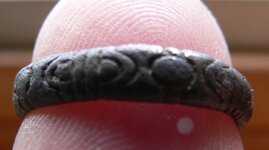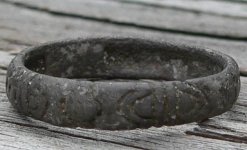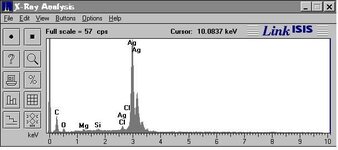Cubfan64
Silver Member
- Feb 13, 2006
- 2,994
- 2,818
- Detector(s) used
- Fisher CZ21, Teknetics T2 & Minelab Sovereign GT
- Primary Interest:
- All Treasure Hunting
I went to Hampton Beach N.H. very early Saturday morning in hopes that some higher than average waves and a little wind might leave some trinkets behind. It was REALLY CREEPY being there starting at 2am because there was so much fog you couldn't see much beyond 50 feet or so. Every time I turned my back to the ocean I had this image of the creature from the black lagoon or a bunch of undead pirates rising out of the depths to drag me to my death!!!
Although I found alot of "cuts" in the sand, I didn't have nearly the luck I had hoped with ~$5 in clad but about 20 minutes before leaving I came across this ring which I need some help identifying.
Here are the things I know about it:
1. It has weight to it - it's not aluminum or some lightweight metal.
2. It is NOT attracted to a magnet
3. In the hopes that it is silver and the "tarnish" is silver sulfide I did about a 2 minute electrolysis which basically did nothing to it so I stopped in order to not damage it
4. I don't know how best to describe the feel and texture of it, but it almost feels like lead - it has no "smoothness" to it like you would expect from a ring and it looks handmade because I don't even think it's uniform in thickness all the way around.
I'm taking it to work with me tomorrow to have someone check it under the scanning electron microscope to get an idea of the metalic components, but if anyone here has any ideas, I would really appreciate it!!
Thanks!
Although I found alot of "cuts" in the sand, I didn't have nearly the luck I had hoped with ~$5 in clad but about 20 minutes before leaving I came across this ring which I need some help identifying.
Here are the things I know about it:
1. It has weight to it - it's not aluminum or some lightweight metal.
2. It is NOT attracted to a magnet
3. In the hopes that it is silver and the "tarnish" is silver sulfide I did about a 2 minute electrolysis which basically did nothing to it so I stopped in order to not damage it
4. I don't know how best to describe the feel and texture of it, but it almost feels like lead - it has no "smoothness" to it like you would expect from a ring and it looks handmade because I don't even think it's uniform in thickness all the way around.
I'm taking it to work with me tomorrow to have someone check it under the scanning electron microscope to get an idea of the metalic components, but if anyone here has any ideas, I would really appreciate it!!
Thanks!








